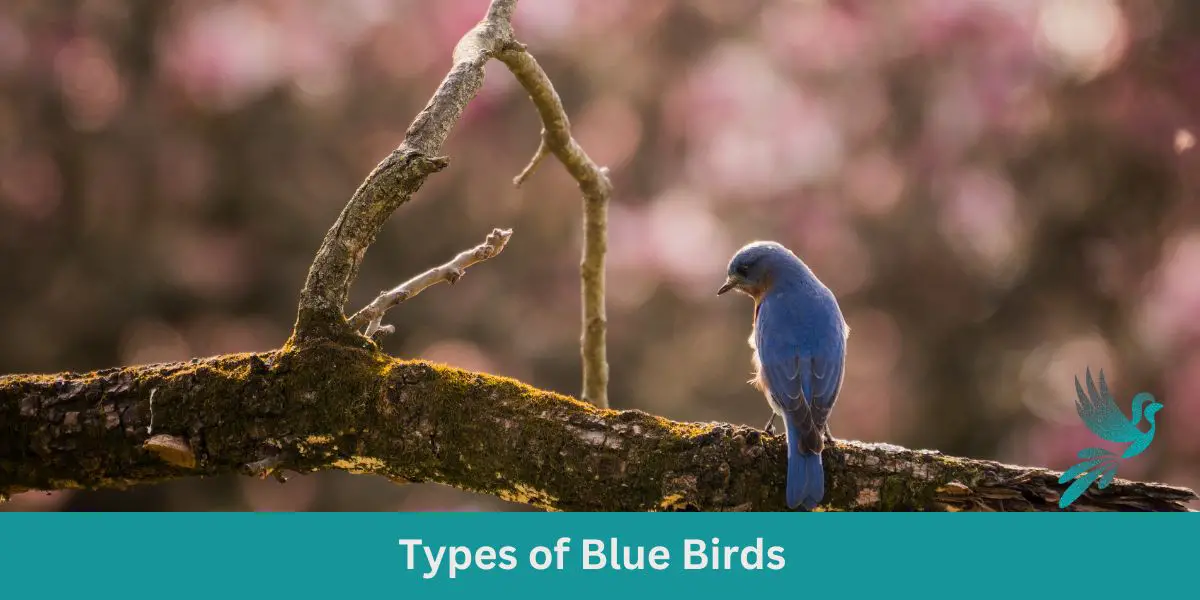Blue birds are some of the most peaceful and relaxing birds to observe. Their calming blue colors are not as common on birds in North America, making them stand out when encountered. In this article, we have compiled a list of our favorite 20 types of blue birds for you to discover and appreciate.
From the Mountain Bluebird found in rocky mountain habitats, to the Blue Grosbeak commonly found in untended fields, we have included a variety of blue bird species in our list. Whether you are a bird enthusiast or simply enjoy observing backyard birds, you are sure to find a blue bird that catches your eye.
Key Takeaways
Blue birds are known for their calming and peaceful colors.
Our list includes 20 different types of blue birds, from the Mountain Bluebird to the Blue Grosbeak.
Whether you are a bird enthusiast or enjoy observing backyard birds, there is a blue bird species for everyone to appreciate.
List of Birds That Are Blue
Eastern Bluebird

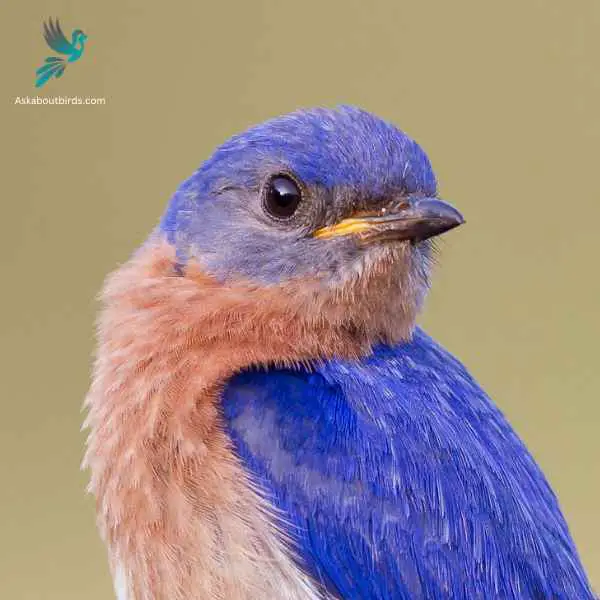
| Feature | Measurement |
|---|---|
| Scientific Name | Sialia sialis |
| Length | 6.3–8.3 in |
| Wingspan | 9.8–12.6 in |
| Weight | 27–34 g |
The Eastern Bluebird (Sialia sialis) is a small thrush found in open woodlands, farmlands, and orchards, and is recognized for its vibrant blue and red coloration. Male Eastern Bluebirds are dazzling with bright blue upperparts and a rusty or brick-red throat and breast, while females, though less colorful, still offer a similar pattern. The bird is native to North America and is commonly seen east of the Rockies, from Canada to the Gulf States and southeastern Arizona to Nicaragua.
Eastern Bluebirds feed on insects, wild fruit and berries. They have a gentle nature and are often seen perched alone or in small groups in the open, scanning the ground for prey. They are cavity nesters and will use old woodpecker holes or birdhouses if they are the right size.
Western Bluebird


| Trait | Western Bluebird |
|---|---|
| Scientific Name | Sialia mexicana |
| Length | 5.5-7 inches |
| Wingspan | 11-13 inches |
| Weight | 0.8-1.1 ounces |
The Western Bluebird is a charismatic bird, appreciated for its vivid coloring and melodious song, commonly observed in open woodlands and meadows of the West.
Appearance: The male Western Bluebird sports a dark blue head, throat, wings, and tail with an orange breast and sides, transitioning into a grayish belly. Females are more muted, displaying grayish-blue wings and tail with a more subdued orange wash on the chest.
Diet: Western Bluebirds predominantly feed on insects, complemented by berries and fruits when available. They hunt by perching and then diving to the ground to capture their prey, and they’re also known to catch insects in mid-air.
Reproduction: These birds often utilize natural tree cavities or nest boxes for breeding. The female builds a loose nest inside and lays a clutch of 4-6 pale blue eggs.
Mountain Bluebird


| Feature | Measurement |
|---|---|
| Scientific Name | Sialia currucoides |
| Length | 6.1–7.1 in |
| Wingspan | 11.0-14.2 in |
| Weight | 24–37 g |
The Mountain Bluebird is a small bird found in open grasslands and rocky mountains of North America. It is known for its stunning blue plumage, which is particularly vibrant in males. Females, on the other hand, have a more subdued blue coloration with hints of gray. These birds have slender bodies and a slightly curved bill, adapted for catching insects on the wing.
Mountain Bluebirds are insectivores, feeding primarily on insects such as beetles, grasshoppers, and spiders. They are skilled aerial hunters, capable of capturing their prey in mid-flight. During breeding season, these birds build their nests in tree cavities or man-made nest boxes, where females lay a clutch of eggs. The male bluebird actively participates in nest-building and provides food for the female during incubation.
Blue Grosbeak
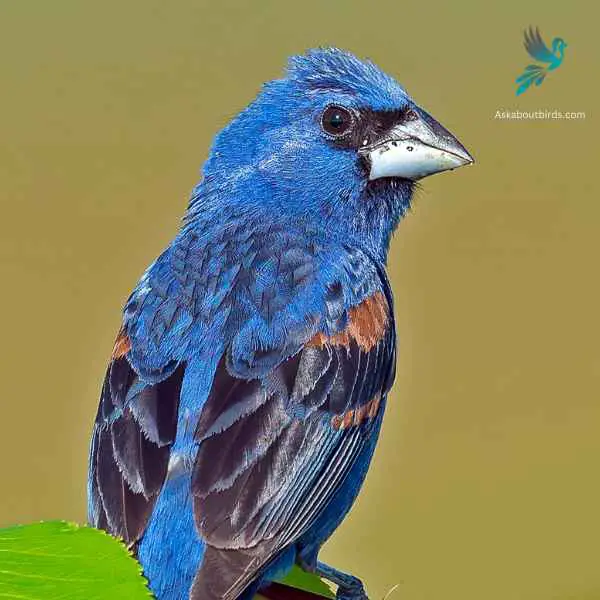

| Feature | Measurement |
|---|---|
| Scientific Name | Passerina caerulea |
| Length | 5.5 to 7.5 in |
| Wingspan | 10 to 11 in |
| Weight | 26 to 31.5 g |
The Blue Grosbeak is a medium-sized songbird found in North and Central America. The male Blue Grosbeak displays stunning plumage with deep blue feathers on its body and head, while the female has more subdued brownish tones. Both sexes have a thick, conical bill, which gives them their name “grosbeak,” meaning large beak.
These birds prefer open habitats such as grasslands, brushy areas, and woodland edges. Blue Grosbeaks are known for their melodious songs, which consist of a series of rich and varied notes. They primarily feed on seeds and insects, using their strong beaks to crack open seeds and forage on the ground or in low vegetation.
Black-throated Blue Warbler
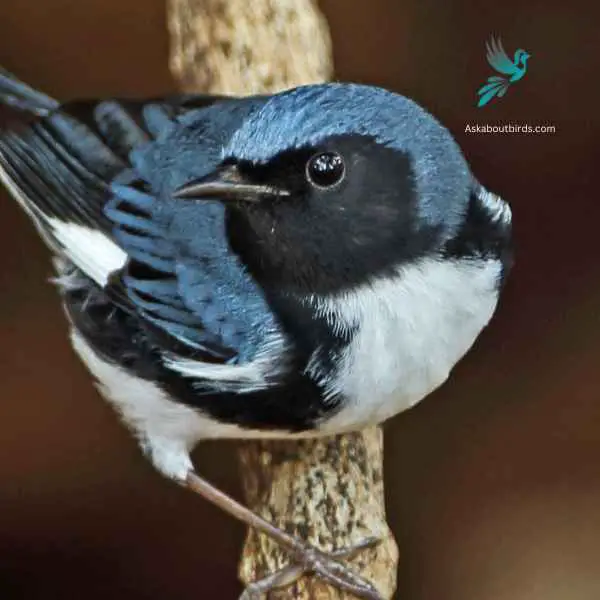

| Feature | Measurement |
|---|---|
| Scientific Name | Setophaga caerulescens |
| Length | 5.1 in |
| Wingspan | 7.5-7.9 in |
| Weight | 8.4–12.4 g |
The Black-throated Blue Warbler is a small migratory bird that breeds in the eastern United States and parts of Canada. The male Black-throated Blue Warbler displays a striking appearance with deep blue plumage on its upperparts, contrasting sharply with a black throat and a white belly. Females, on the other hand, have more muted colors, featuring grayish-olive plumage with a lighter throat.
These warblers prefer deciduous and mixed woodlands, where they forage actively for insects and spiders. They have a slender bill, which they use to extract prey from foliage and tree bark. During the breeding season, males perform courtship displays, showcasing their vibrant plumage and singing a high-pitched song to attract mates.
Black-throated Blue Warblers are known for their long-distance migration. They spend their winters in the Caribbean and Central America, where they inhabit various forested habitats. They construct cup-shaped nests in trees or shrubs, often placing them close to the ground.
Indigo Bunting
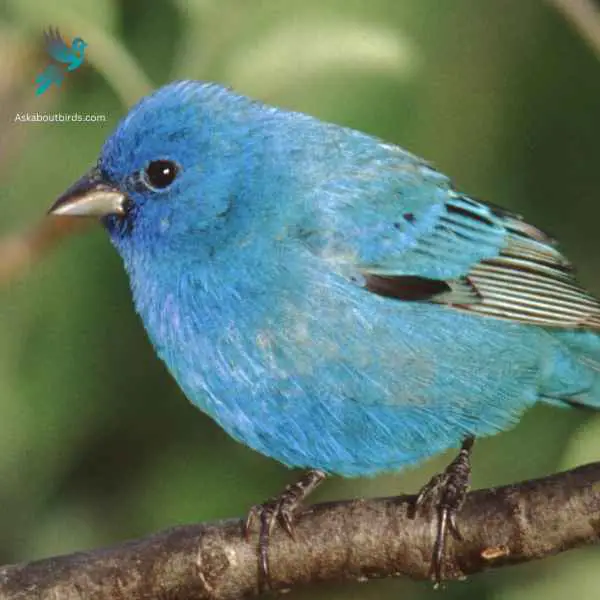

| Feature | Measurement |
|---|---|
| Scientific Name | Passerina cyanea |
| Length | 4.5–5.1 in |
| Wingspan | 7.1–9.1 in |
| Weight | 11.2–21.4 g |
The Indigo Bunting is a strikingly vibrant songbird, often hailed for its brilliant blue plumage and melodic song that graces woodlands and meadows during the warmer months.
Appearance: Males are renowned for their bright indigo blue feathers, which can appear darker in certain lights. Females and juveniles, on the other hand, are brown with subtle hints of blue on their wings and tail. The species lacks the vibrant streaking or spotting commonly found in many other songbirds.
Diet: Indigo Buntings primarily subsist on seeds, especially during non-breeding seasons. During the breeding season, they also consume a variety of insects such as beetles, caterpillars, and spiders, providing essential protein for their growing chicks.
Reproduction: Indigo Buntings build their nests close to the ground in shrubs or low tree branches. These nests, crafted meticulously with grasses and other plant materials, cradle clutches of typically 3 to 4 eggs. After hatching, the young are fed by both parents until they’re ready to fledge.
Blue-gray Gnatcatcher

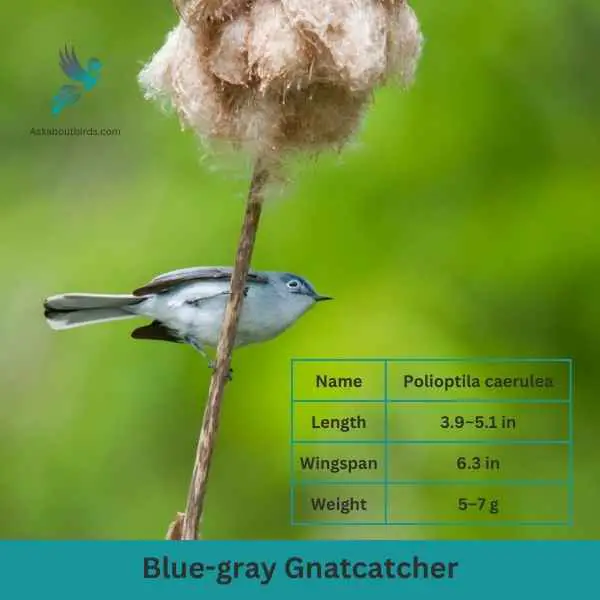
| Feature | Measurement |
|---|---|
| Scientific Name | Polioptila caerulea |
| Length | 3.9–5.1 in |
| Wingspan | 6.3 in |
| Weight | 5–7 g |
The Blue-gray Gnatcatcher is a petite, active bird, frequently observed flitting about treetops, emitting its distinctive high-pitched calls as it moves agilely through the branches.
Appearance: This bird exhibits a predominantly blue-gray plumage with a subtle white eye ring and long, slender tail feathers. The tail has distinctive black and white edging, with the males sometimes showing a faint black line on their forehead during the breeding season.
Diet: Blue-gray Gnatcatchers primarily feed on small insects and spiders. They’re adept hunters, foraging actively among foliage and even catching insects in mid-air.
Reproduction: These birds weave compact, cup-shaped nests on tree branches using plant materials, spider webs, and lichen. The exterior of the nest often matches the tree bark, making it well camouflaged. Inside, the female lays a clutch of 3 to 5 blue or greenish eggs, which she incubates.
Blue Jay
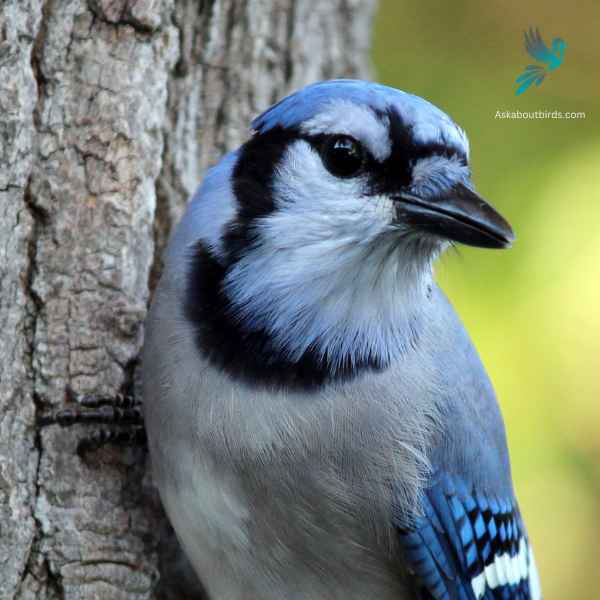
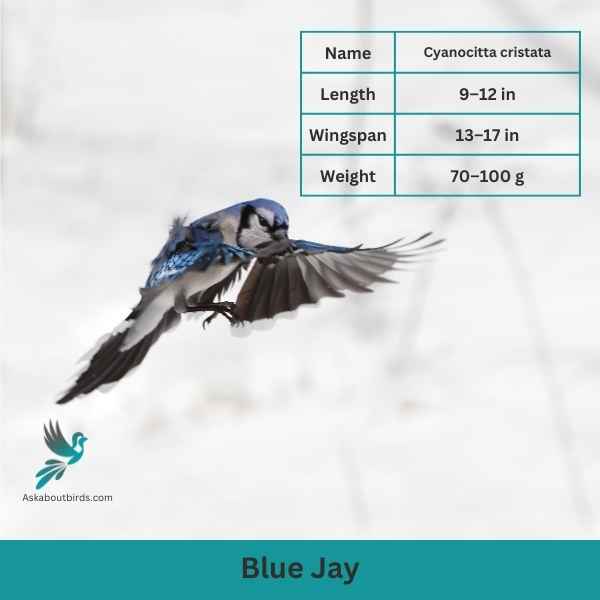
| Feature | Measurement |
|---|---|
| Scientific Name | Cyanocitta cristata |
| Length | 9–12 in |
| Wingspan | 13–17 in |
| Weight | 70–100 g |
The Blue Jay is a vibrant and easily recognized bird, known for its intelligence, distinctive calls, and bold behavior, commonly found throughout the eastern and central United States.
Appearance: The Blue Jay sports a striking blue upper body with white and black markings. Its face has a pronounced white patch with a black necklace that runs across the throat and around the head. The bird also features a pronounced blue crest, which can be raised or lowered, and its wings and tail are brightly colored with black bars and white tips.
Diet: Blue Jays are omnivores. Their diet consists primarily of seeds, nuts, especially acorns, fruits, and small insects. They’ve also been known to eat eggs or nestlings of other birds occasionally. Blue Jays often store food items in caches to eat later.
Reproduction: Blue Jays are monogamous birds that form long-lasting pair bonds. They typically build their nests in trees or large shrubs, constructing them from twigs, grass, and sometimes using mud as a binder. The female lays a clutch of 3 to 6 eggs, which are pale blue or sometimes white with brown speckles.
Lazuli Bunting


| Feature | Measurement |
|---|---|
| Scientific Name | Passerina amoena |
| Length | 5.1-5.9 in |
| Wingspan | 8.7 in |
| Weight | 13-18 g |
The Lazuli Bunting is a vibrant songbird recognized for its brilliant colors and melodious song, frequently seen in brushy areas and woodlands during the summer months.
Appearance: The male boasts a dazzling bright blue head and back, offset by a white belly and rust-orange breast. Females and immature birds present a more muted brownish hue overall, with a hint of blue on the wings and tail.
Diet: Lazuli Buntings primarily feed on seeds, but during the breeding season, they’ll also consume insects. Their strong, conical beaks are perfectly adapted for seed-cracking.
Reproduction: The female Lazuli Bunting constructs a cup-shaped nest using grasses, twigs, and other fine materials, often placing it in a shrub or low tree. She typically lays a clutch of 3-4 pale blue or white eggs.
Steller’s Jay

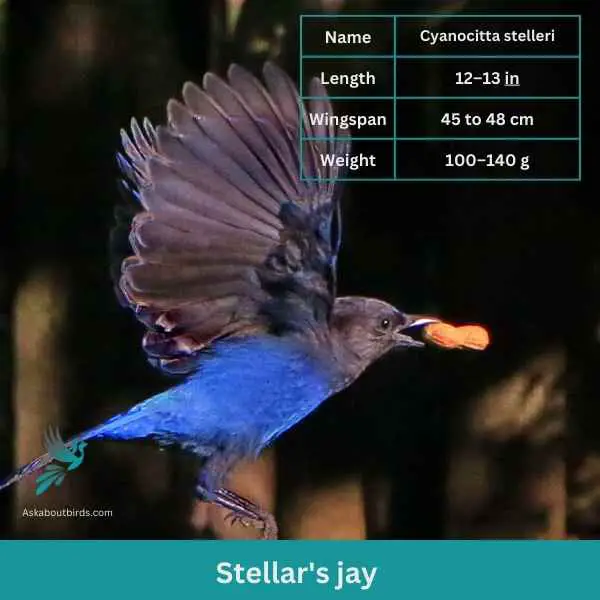
| Feature | Measurement |
|---|---|
| Scientific Name | Cyanocitta stelleri |
| Length | 12–13 in |
| Wingspan | 45 to 48 cm |
| Weight | 45 to 48 cm |
The Steller’s Jay is a charismatic and easily recognizable bird found mainly in the coniferous forests of the western North America, known for its bold behavior and loud, varied calls.
Appearance: The Steller’s Jay has a striking color contrast with a deep blue body and wings and a blackish head and upper body. One of its most distinguishing features is the tall, dark crest on its head, which can be raised or lowered depending on the bird’s mood. Its eyes are dark and its beak is strong and black.
Diet: The Steller’s Jay is omnivorous. It feeds on a wide range of items, from seeds, nuts, and berries to insects and small animals. It’s also known to raid campsites and picnics, often scavenging for human food.
Reproduction: Steller’s Jays form monogamous pairs that often remain together for several years. They typically build their nests in coniferous trees, made from twigs, moss, and other plant materials. The female lays a clutch of 2 to 6 eggs, which are usually pale green or blue with brown spots.
California Scrub-Jay

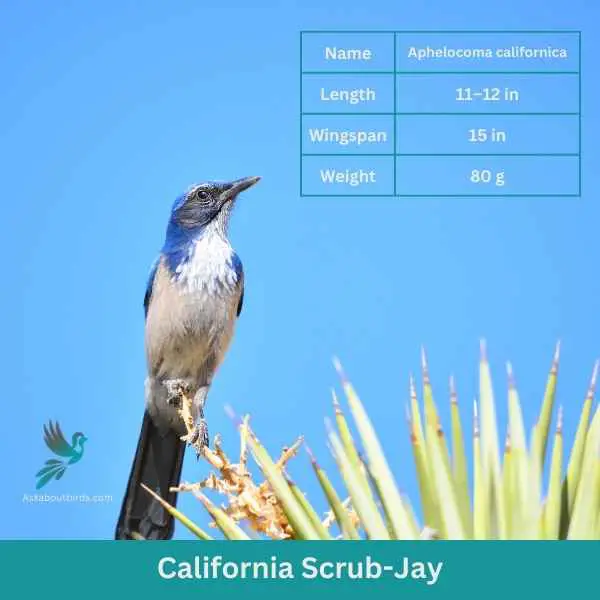
| Feature | Measurement |
|---|---|
| Scientific Name | Aphelocoma californica |
| Length | 11–12 in |
| Wingspan | 15 in |
| Weight | 80 g |
The California Scrub-Jay is a vivacious bird known for its intelligence and striking appearance, predominantly found in the chaparral, oak woodlands, and residential areas of California and parts of the Pacific Northwest.
Appearance: This jay boasts a vivid blue head, wings, and tail, complemented by a pronounced white eyebrow, a white underbelly, and a soft gray back. A distinguishing feature is the blue necklace or band across its throat and chest, which differentiates it from some other jay species.
Diet: California Scrub-Jays are omnivorous. Their diet consists of insects, fruits, seeds, and nuts, with acorns being a particular favorite. They, like their Floridian counterparts, will also cache acorns and other foods in the ground to consume later.
Reproduction: The California Scrub-Jay forms monogamous pairs. The nests, usually built between 1 to 3 meters off the ground in trees or shrubs, are constructed using twigs and lined with finer materials like hair or plant fibers. The female lays a clutch of 3 to 6 eggs that are greenish or bluish and speckled with brown.
Florida Scrub-Jay
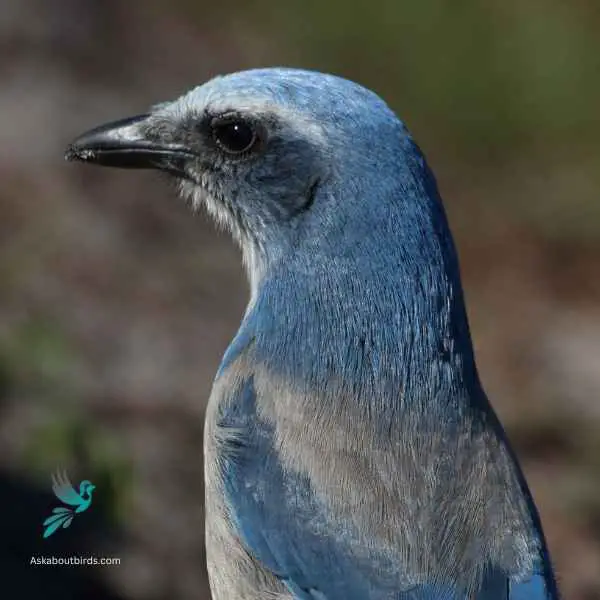
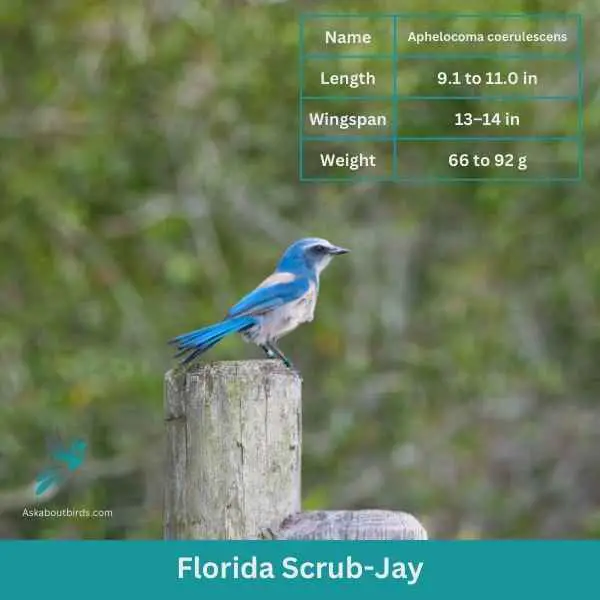
| Feature | Measurement |
|---|---|
| Scientific Name | Aphelocoma coerulescens |
| Length | 9.1 to 11.0 in |
| Wingspan | 13–14 in |
| Weight | 66 to 92 g |
The Florida Scrub-Jay is a striking, cooperative-breeding bird endemic to the sandy scrublands of Florida. It stands out as the only species of bird restricted entirely to the state of Florida.
Appearance: The Florida Scrub-Jay exhibits a bright blue head, wings, and tail, contrasting with its pale gray underbelly and nape. Its stout bill, legs, and eyes are black. Unlike other jays, it lacks a crest on its head.
Diet: Primarily, the diet of the Florida Scrub-Jay consists of a variety of insects and small animals, seeds, and especially acorns. They have a unique behavior of storing thousands of acorns, burying them in the ground as a food reserve for the lean winter months.
Reproduction: These jays are monogamous and often form family groups. They typically nest in shrubs or low trees. The nest, built primarily by the female, is made of twigs and lined with fine plant material. The female lays a clutch of 3 to 4 eggs, which are pale greenish or bluish and spotted with brown.
Tree Swallow
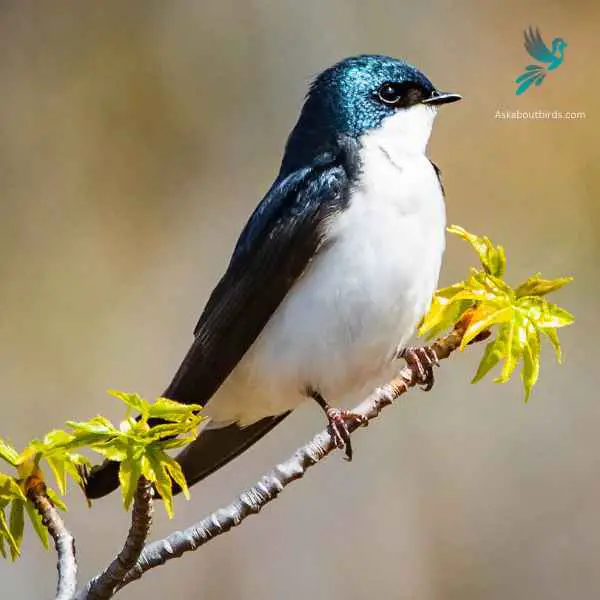

| Feature | Measurement |
|---|---|
| Scientific Name | Tachycineta bicolor |
| Length | 4.7 and 5.5 in |
| Wingspan | 12 to 14 in |
| Weight | 17 to 25.5 g |
The Tree Swallow is a graceful and agile bird, best recognized for its iridescent blue-green upperparts and sweeping flight patterns over open fields and water.
Appearance: The Tree Swallow is sleek with a streamlined body. The upperparts shine with a blue-green iridescence while the underparts are white. They possess long, pointed wings and a slightly forked tail, aiding in their agile flight.
Diet: Tree Swallows primarily feed on flying insects, skillfully catching them mid-air. During colder months when insects are scarce, they can switch to a diet of berries, particularly those of the bayberry, which other birds might find hard to digest.
Reproduction: Tree Swallows are cavity-nesters, typically choosing natural holes in trees or using bird boxes. They line their nests with feathers, creating a soft environment for the eggs. The female will lay a clutch of 4 to 7 white eggs.
Barn Swallow

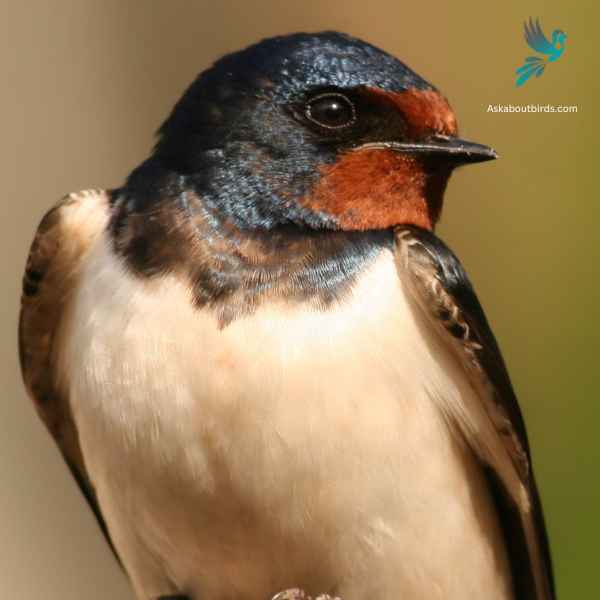
| Feature | Measurement |
|---|---|
| Scientific Name | Hirundo rustica |
| Length | 6.5–7.5 in |
| Wingspan | 12.5–13.5 in |
| Weight | 16–22 g |
The Barn Swallow is a sleek, agile bird renowned for its graceful flight patterns and iconic forked tail, often seen darting over fields and water bodies in search of flying insects.
Appearance: Barn Swallows have deep blue, almost iridescent, upperparts and a rufous to tawny underbelly. Their distinctively forked tail and long wings give them a streamlined look. Both males and females have a similar appearance, though males often exhibit slightly brighter colors and a deeper fork in the tail.
Diet: Barn Swallows feed primarily on flying insects, which they catch in mid-air during their agile and acrobatic flights. Their diet includes flies, beetles, moths, and other small flying insects.
Reproduction: Barn Swallows are known for building their mud nests on man-made structures, particularly barns, bridges, and eaves. The nest is cup-shaped and made from mud pellets, often lined with feathers. The female lays a clutch of 4 to 6 eggs.
Cerulean Warbler

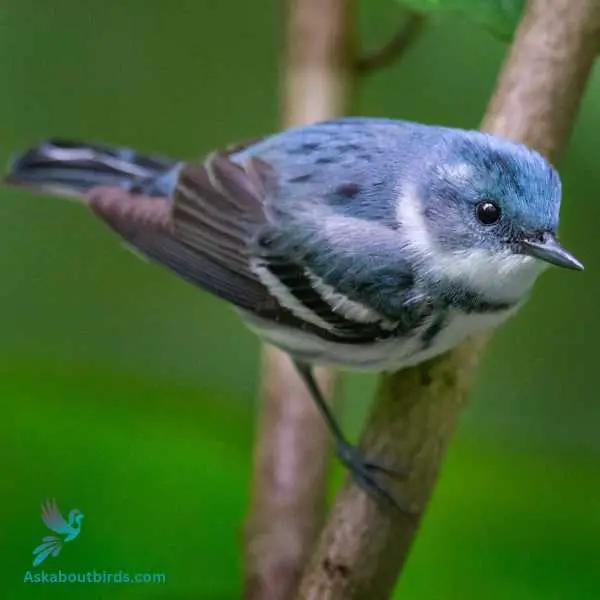
| Trait | Cerulean Warbler |
|---|---|
| Scientific Name | Setophaga cerulea |
| Length | 4.5 inches |
| Wingspan | 7.9-8.7 inches |
| Weight | 0.3-0.4 ounces |
The Cerulean Warbler is a striking songbird known for its sky-blue plumage and flitting movements in the forest canopy.
Appearance: Males boast a vibrant cerulean blue color on their upperparts, with streaked underparts, and a black necklace. Females have a more subdued bluish-green hue and lack the prominent black markings seen in males.
Diet: The diet of the Cerulean Warbler is predominantly made up of insects and spiders. They actively forage high in the treetops, gracefully maneuvering through leaves and branches.
Reproduction: Cerulean Warblers nest in the upper branches of tall deciduous trees. The female weaves a shallow cup-shaped nest and lays a clutch of 3-5 eggs.
Blue-winged Warbler


| Trait | Blue-winged Warbler |
|---|---|
| Scientific Name | Vermivora cyanoptera |
| Length | 4.3-4.7 inches |
| Wingspan | 6.7-7.5 inches |
| Weight | 0.3-0.4 ounces |
The Blue-winged Warbler is a vibrant songbird that stands out with its lemon-yellow coloring and buzzing song.
Appearance: This warbler displays a brilliant yellow body contrasted by blue-gray wings and a slim, black line through the eyes. The wings also feature two white wing bars.
Diet: The diet of the Blue-winged Warbler primarily consists of insects and spiders. They actively forage in shrubs and low trees, picking off their prey from the foliage.
Reproduction: Blue-winged Warblers build their nests on or near the ground, using grasses and other fine materials. The female lays a clutch of 4-6 eggs, which she incubates.
Blue-headed Vireo
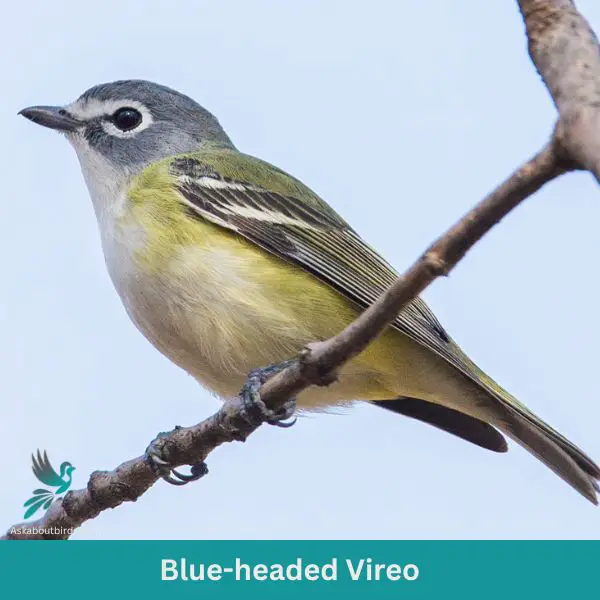

| Trait | Blue-headed Vireo |
|---|---|
| Scientific Name | Vireo solitarius |
| Length | 5-5.5 inches |
| Wingspan | 7.9-9.8 inches |
| Weight | 0.4-0.6 ounces |
The Blue-headed Vireo is a songbird recognized for its sharp and clear song as well as its distinct coloration.
Appearance: It has a blue-gray head and nape, contrasting sharply with its white throat and belly. A white eye ring combined with two white wing bars and yellowish flanks further accentuate its appearance.
Diet: The Blue-headed Vireo feeds mainly on insects and spiders. It often forages in the forest canopy, picking prey off leaves and twigs.
Reproduction: The female constructs a cup-shaped nest made of twigs, bark, and spiderwebs, often placed in the fork of a tree branch. Typically, she lays a clutch of 3-5 eggs. Both parents share the responsibility of incubating the eggs and feeding the chicks.
Northern Parula
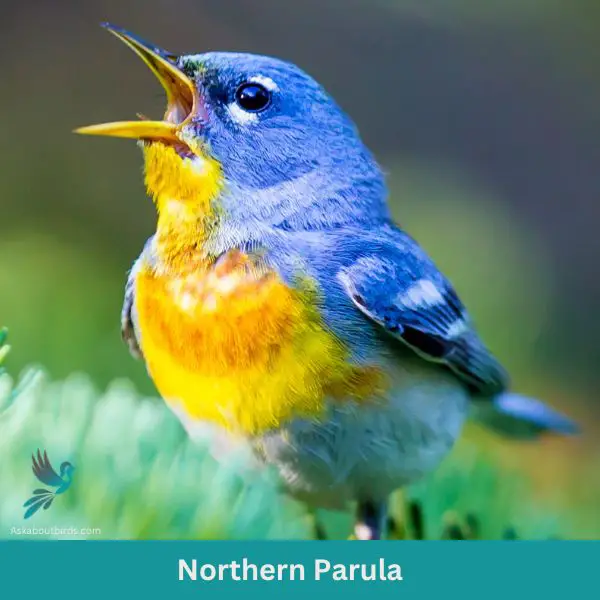

| Trait | Northern Parula |
|---|---|
| Scientific Name | Setophaga americana |
| Length | 4.3-4.7 inches |
| Wingspan | 6.3-7.1 inches |
| Weight | 0.2-0.4 ounces |
The Northern Parula is a small, brightly colored warbler with vibrant shades of blue and yellow, often seen flitting about the tree canopy.
Appearance: This warbler boasts a blue-gray upper body with a green patch on the back and two white wing bars. Males have a distinctive band of rufous and black on the chest, while females are more muted in color, often lacking the chest band entirely. Both genders display a bright yellow patch on the throat and upper chest.
Diet: Northern Parulas primarily feed on insects and spiders. They forage actively in the tree canopy, often hanging upside down to glean their prey from leaves and branches.
Reproduction: Northern Parulas typically nest in hanging vegetation like Spanish moss or beard lichen. The female constructs a pendant-shaped nest and lays a clutch of 3-5 eggs.
Belted Kingfisher

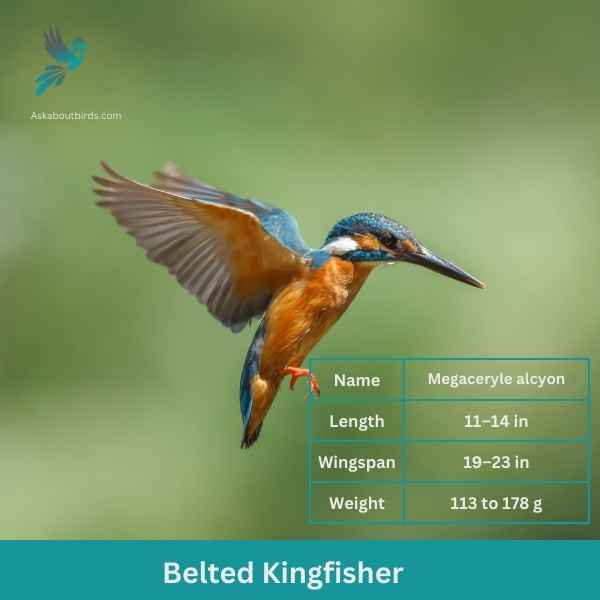
| Feature | Measurement |
|---|---|
| Scientific Name | Megaceryle alcyon |
| Length | 11–14 in |
| Wingspan | 19–23 in |
| Weight | 113 to 178 g |
The Belted Kingfisher is a distinctive and easily recognizable bird, frequently observed near water bodies, where it can be seen diving headfirst to catch prey.
Appearance: Sporting a prominent crest, the Belted Kingfisher has a slate blue-gray upper body and white underparts. Males possess a single blue band across their white chests, while females have an additional rufous band, making them one of the few bird species where females are more brightly colored than males. Their bill is long, sharp, and dagger-like.
Diet: As expert fishers, Belted Kingfishers mainly prey on small fish, but they’ll also consume crustaceans, insects, and amphibians. They’re known for their hunting tactic of hovering over water, spotting their prey, and then diving swiftly to snatch it.
Reproduction: Belted Kingfishers nest in burrows which they excavate in sandy or earthen banks, usually adjacent to water. The tunnel can be anywhere from 3 to 6 feet long, ending in a chamber. Within this chamber, the female lays a clutch of 5 to 8 white eggs.
Little Blue Heron
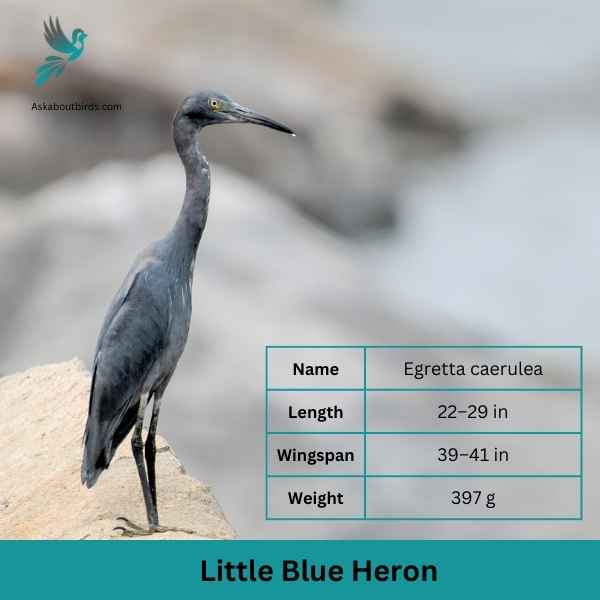
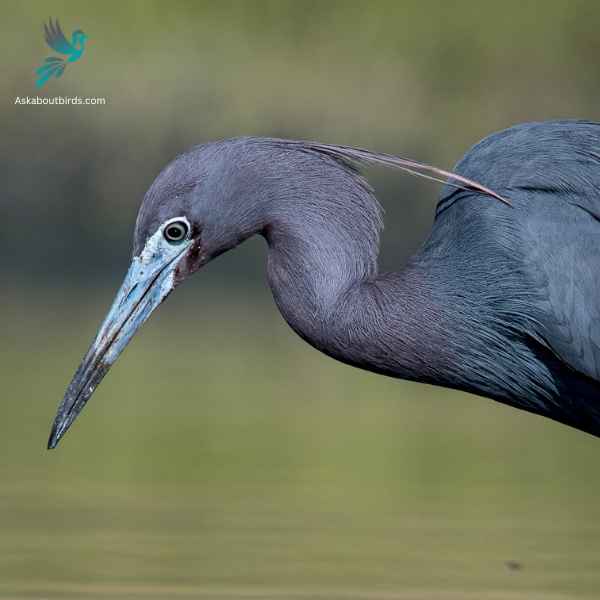
| Feature | Measurement |
|---|---|
| Scientific Name | Egretta caerulea |
| Length | 22–29 in |
| Wingspan | 39–41 in |
| Weight | 397 g |
The Little Blue Heron is a slender and elegant wading bird, often seen foraging in freshwater or saltwater habitats, especially in the southeastern parts of the United States.
Appearance: This heron undergoes a fascinating color transition as it matures. Juvenile Little Blue Herons are white, but they gradually acquire the slate-blue plumage that characterizes adults. The adult has a dark blue-gray body with a purplish neck and head. Their bill is grayish with a black tip.
Diet: The diet of the Little Blue Heron consists mainly of small fish, but they also feed on crustaceans, insects, and other small aquatic animals. Using stealth, they slowly stalk their prey in shallow waters before striking with their long, sharp bill.
Reproduction: Little Blue Herons nest in colonies, often with other wading birds. They build platform nests in trees or shrubs close to water bodies. The female typically lays a clutch of 3 to 5 pale blue eggs. Both parents participate in incubation and feeding the chicks once they hatch.
FAQS on Blue Bird Species
How do birds get their blue pigment?
Interestingly, birds don’t produce blue pigments at all! The blue we see in birds like blue jays and bluebirds isn’t a result of pigments, but rather a structural coloration.
Here’s how it works:
- Structure Over Pigment: Instead of relying on pigments, the blue color in birds comes from the way light interacts with the microscopic structure of their feathers.
- Scattering of Light: The blue appearance is a result of the Tyndall effect. When light hits the feathers, it is scattered by the protein structures within them. The feather structure causes shorter blue wavelengths of light to scatter more than the other colors. As a result, our eyes pick up this scattered blue light, making the feathers appear blue.
- No True Blue Pigment: Unlike some other colors in birds which come from actual pigments (like melanins for light brown birds and blacks or carotenoids for yellows and reds birds), there isn’t a true blue pigment in birds.
What is the most common blue bird?
The Eastern Bluebird is often regarded as the most common blue bird in North America, particularly in the eastern regions. This bird, with its vibrant blue back and rust-orange chest, can be found in gardens, farmlands, and open woodlands. Its cheerful song and striking appearance make it a favorite among birdwatchers and nature enthusiasts.
What blue colored bird is solid blue?
The Indigo Bunting is a bird that’s predominantly solid blue. These small birds flaunt an almost electric blue plumage, especially in males during the breeding season. Though the females are brown, the striking blue males are unmistakable when observed under direct sunlight.
How many bird species are blue?
There isn’t a precise number for how many bird species are blue, as “blue” can vary from pale blue to dark indigo shades, and many birds have only patches of blue. However, there are dozens of species worldwide with varying degrees of blue in their plumage, from blue jays to kingfishers to fairy-wrens.
What is a small dark blue bird?
The Dark-eyed Junco is a small bird that sometimes appears in a dark slate-colored or bluish variant, particularly in the eastern populations. Found across North America, these birds are known for their hopping movements on the ground and their distinctive, sharp chirps. They’re a common sight, especially in winter, often visiting backyard feeders.

